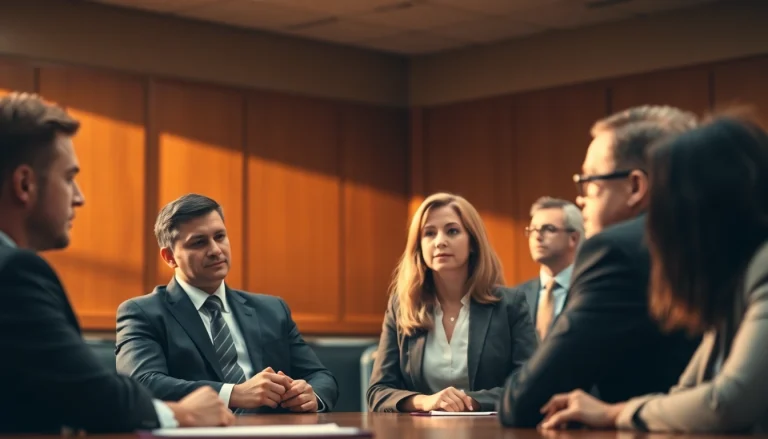
Understanding Mass Tort Marketing
Mass tort marketing represents a specialized segment of legal marketing that targets a group of individuals collectively harmed by a common entity or product, such as defective drugs or environmental disasters. This type of marketing not only serves to inform potential clients of their rights but also seeks to facilitate connections between affected individuals and legal representation. The strategies deployed within mass tort marketing are critical for law firms looking to navigate the complexities of litigation while achieving a favorable outcome for their clients. Understanding the nuances of this marketing technique is essential for any legal professional aiming to engage successfully in this arena.
What Is Mass Tort Marketing?
Mass tort marketing is a legal marketing practice designed to pursue claims from a large group of individuals who have been injured or negatively affected as a result of the same entity’s actions. Unlike class action lawsuits, where the recovery amounts may be shared among a large group, mass torts allow each plaintiff to seek individual compensation based on their unique damages. This distinction is crucial for marketing efforts, as they must address individual narratives while also appealing to a collective issue. Effective mass tort campaigns can significantly enhance a firm’s visibility and client acquisition by leveraging various platforms to reach affected individuals.
Key Components of Successful Mass Tort Campaigns
A successful mass tort campaign generally comprises several critical components, including:
- Targeted Messaging: Crafting messages that resonate emotionally with potential clients, emphasizing the collective struggle and the importance of legal representation.
- Multichannel Outreach: Employing various marketing channels—like social media, digital ads, and email marketing—to maximize reach and engagement.
- Clear Call to Action: Providing straightforward steps for potential clients to connect with legal professionals, emphasizing urgency and necessity.
- Follow-Up Systems: Implementing systems to follow up with interested parties to nurture leads effectively and guide them through the legal process.
Common Misconceptions About Mass Tort Marketing
Despite its growing significance, mass tort marketing is often surrounded by misconceptions. Some common myths include:
- It’s Just About Advertising: Many believe mass tort marketing is merely about putting out ads. However, it requires strategic planning and understanding of the target audience’s circumstances.
- All Cases Are the Same: While cases may stem from similar issues, each client’s situation is unique, necessitating personalized marketing approaches.
- High Competition Equals Low Success Rates: While competition is indeed high, targeted strategies and effective messaging can still yield successful client acquisitions.
Identifying Your Target Audience
Knowing your target audience is paramount in mass tort marketing. Identifying who has been affected, their demographics, and their potential needs allows law firms to tailor their messaging effectively. This process involves a combination of demographic analysis, market research, and creating detailed buyer personas.
Defining Demographics for Mass Tort Cases
Demographics play a crucial role in mass tort marketing as they define the characteristics of the target population. Factors such as age, gender, income level, education, and geographic location can all influence how messages are crafted and delivered. For example, younger audiences may prefer digital communication via social media, while older demographics might respond better to email or traditional mail campaigns.
Conducting Market Research in the Legal Field
Effective market research is instrumental in understanding the landscape of mass tort cases. This involves analyzing recent trends, identifying common grievances, and determining the most notable cases currently being litigated. Law firms can utilize tools like surveys, focus groups, and data analysis to gather insights. Engaging with legal forums and industry reports can also provide valuable information to hone in on targeted efforts.
Building Buyer Personas for Better Targeting
Creating buyer personas helps legal marketers visualize their potential clients. By developing profiles that summarize characteristics, needs, and preferred communication methods, marketers can fine-tune their approaches. A well-defined buyer persona for mass tort clients might include details such as:
- Demographic information (age, gender, income, etc.)
- Common pain points and challenges faced due to the injury
- Preferred communication channels
- Potential motivations for seeking legal assistance
These personas are invaluable in crafting messages that resonate deeply, increasing the likelihood of engaging effectively.
Developing a Robust Marketing Strategy
A well-rounded marketing strategy is essential for the success of mass tort campaigns. By combining elements of digital marketing with compelling content creation, law firms can significantly enhance their outreach and conversion rates.
Utilizing Digital Marketing Channels for Mass Torts
Digital marketing channels offer law firms a versatile platform to reach potential clients. Here are several key strategies:
- Search Engine Optimization (SEO): Optimizing content with relevant keywords can increase visibility in search engine results. For example, utilizing terms like Mass Tort Marketing ensures that content reaches those actively seeking information.
- Pay-Per-Click Advertising (PPC): Targeted PPC campaigns allow firms to reach specific demographics. Ads can be strategically placed to appear in search results relevant to ongoing mass tort cases.
- Social Media Campaigns: Engaging content shared across social platforms can tap into community discussions, increasing brand awareness and credibility.
- Email Marketing: Regular newsletters and informational emails can keep potential clients informed and engaged, promoting outreach and trust.
Content Marketing Strategies to Engage Potential Clients
Content marketing serves as a critical component of a robust mass tort marketing strategy. High-quality, informative content can position a law firm as a trusted authority in legal matters. Effective content could include:
- Blog Posts: Regularly updated blogs on mass tort issues provide ongoing value and information to potential clients.
- Whitepapers & E-books: Detailed guides on mass tort processes can serve as lead magnets to draw in inquiries.
- Webinars and Videos: Interactive content allows firms to explain complex legal matters clearly and build rapport with potential clients.
- Client Testimonials and Case Studies: Sharing stories of successful mass tort cases can enhance credibility and attract similar clients.
Measuring Campaign Effectiveness and ROI
It is crucial to have metrics in place to evaluate the effectiveness of mass tort marketing strategies. Key performance indicators (KPIs) could include:
- Website traffic and engagement rates
- Conversion rates from ad clicks to inquiries
- Lead generation metrics from various campaigns
- Social media engagement and interactions
By continuously measuring these metrics, firms can refine their strategies for better performance and outcomes.
Legal Compliance in Mass Tort Marketing
Marketing for mass tort cases must be conducted within the confines of legal and ethical standards. Understanding these regulations is crucial to avoid pitfalls that could jeopardize both the campaign and the law practice.
Understanding Regulations Affecting Mass Tort Advertising
Legal advertising is subject to state regulations that dictate what can be communicated to potential clients. It is important for law firms to be aware of these rules to ensure compliance. Common regulations may involve:
- Restrictions on client testimonials and endorsements
- Prohibiting misleading claims or guarantees of outcomes
- Mandating disclaimers when providing free consultations
Understanding and adhering to these regulations protects a firm’s reputation while ensuring that potential clients receive honest and accurate information.
Ethical Considerations for Law Firms in Marketing
Beyond regulations, firms must also consider ethical implications. Law firms have an obligation to uphold the integrity of the legal profession. Ethical marketing practices involve transparency, honesty, and respect for client privacy. Lawyers should avoid aggressive tactics that may mislead or exploit vulnerable potential clients, ensuring that all communications promote informed decision-making.
Best Practices for Compliance and Transparency
To maintain compliance and transparency in mass tort marketing, law firms should consider the following best practices:
- Stay Updated: Regularly review state regulations and ethical guidelines to remain compliant with advertising standards.
- Utilize Clear Language: Avoid legal jargon and provide information in straightforward terms that clients can understand.
- Encourage Questions: Create open lines of communication, inviting potential clients to ask questions and clarify any uncertainties.
- Document Everything: Maintain detailed records of marketing campaigns and communications with clients to ensure accountability.
Leveraging Technology and Analytics
Embracing technology and analytics is essential for optimizing mass tort marketing efforts. Tools and technologies can streamline processes, enhance outreach, and provide invaluable insights into campaign performance.
Using Analytics to Optimize Mass Tort Marketing Campaigns
Analytics play a vital role in understanding the effectiveness of marketing strategies. Law firms should utilize tools such as Google Analytics, CRM software, and marketing automation platforms to gather and analyze data. Key metrics to track include:
- Traffic sources and user behavior on the website
- Engagement on social media posts and ads
- Email open and click-through rates
- Conversion rates and lead sources
By deriving insights from this data, adjustments can be made for optimal performance, ensuring that marketing strategies resonate with the target audience.
Emerging Technologies in Legal Marketing
Several emerging technologies are reshaping the landscape of legal marketing. Innovations such as artificial intelligence (AI), machine learning, and chatbots can enhance law firms’ approaches to client interaction and case management:
- AI-Powered Legal Research: Tools that utilize AI can assist in identifying trends in mass tort litigation, facilitating more informed marketing strategies.
- Chatbots: Implementing chatbots on websites allows for real-time engagement with potential clients, providing immediate responses to inquiries.
- Data Mining: Using data mining techniques can help firms identify potential leads based on online behavior and social media interactions.
Case Studies of Successful Mass Tort Marketing Implementation
To fully understand the efficacy of mass tort marketing strategies, analyzing real-life case studies can provide insightful examples of successful implementation. For instance, consider the case of a law firm specializing in pharmaceutical mass torts:
The firm launched a multi-channel campaign centered on a particular drug linked to serious health concerns. They utilized:
- SEO-optimized blog content discussing the drug’s risks,
- Targeted PPC advertising to reach affected demographics, and
- Engaging social media posts featuring testimonials from affected individuals who successfully received compensation.
As a result of this comprehensive strategy, the law firm saw a significant uptick in inquiries and successful case acquisitions, ultimately leading to a landmark settlement for clients.






